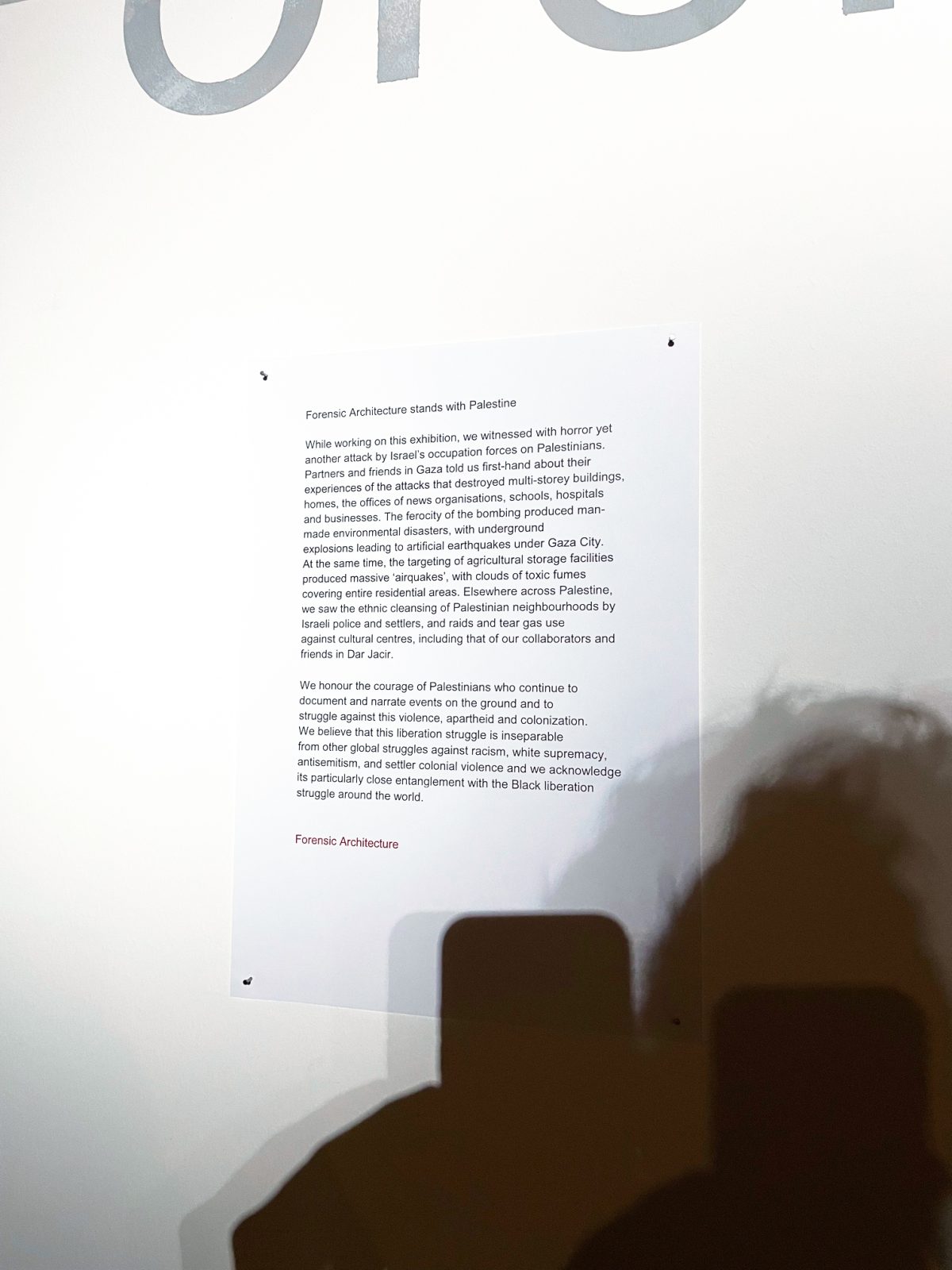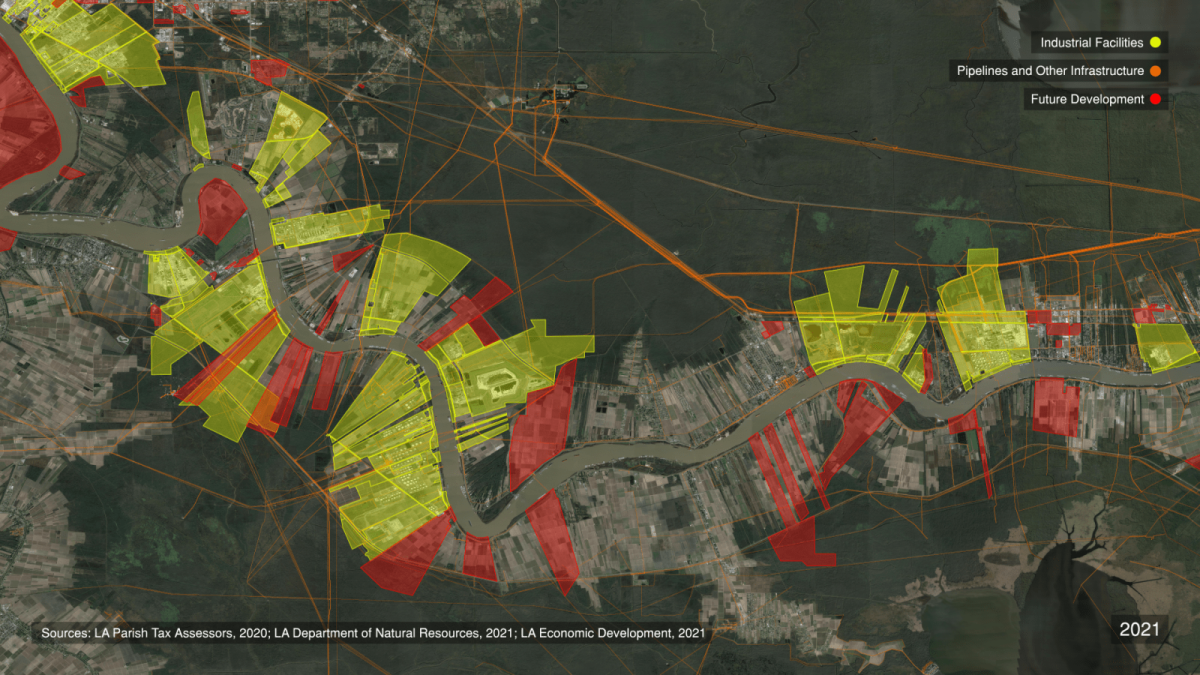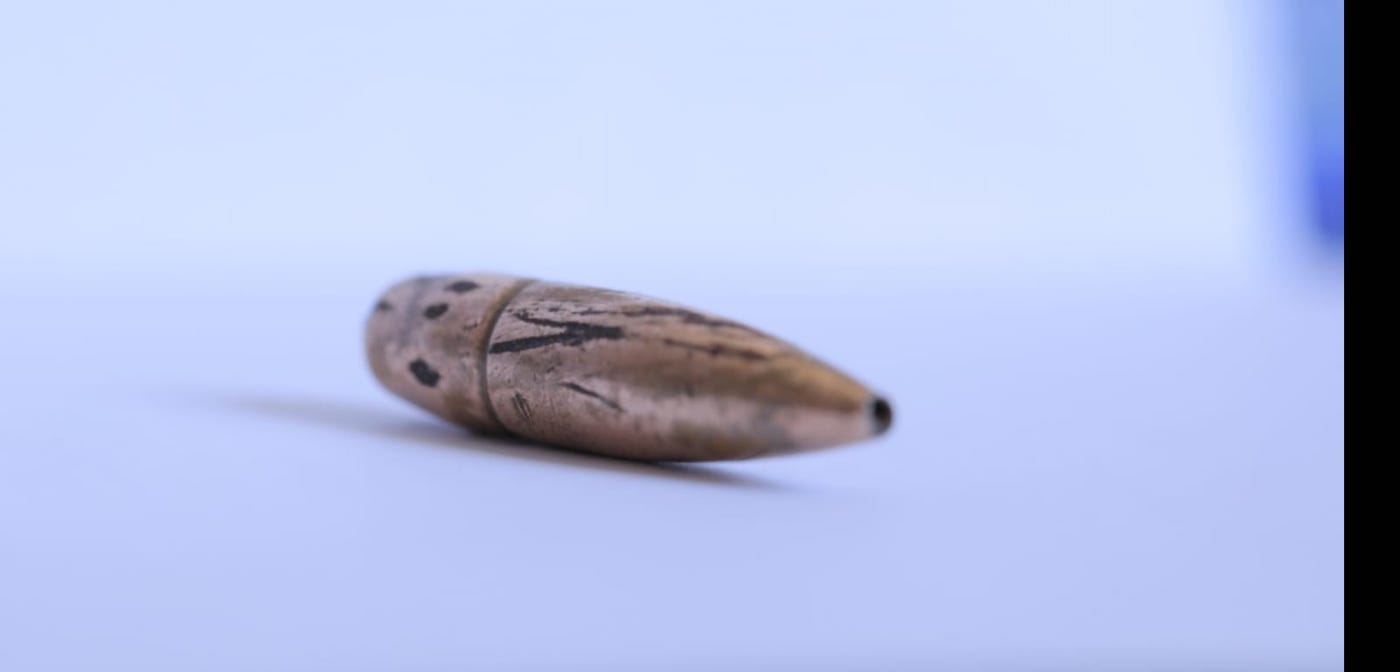Pro-Palestinian Artwork by Forensic Architecture Was Censored by University of Manchester
 Thursday, August 19, 2021 at 01:38PM
Thursday, August 19, 2021 at 01:38PM After learning that its statement had been removed from the exhibition, Forensic Architecture requested that its works be withdrawn from the exhibition.
19 August 2021. By Hakim Bishara Hyperallegic
 Pro-Palestine protesters at the University of Manchester (all images courtesy Forensic Architecture)
Pro-Palestine protesters at the University of Manchester (all images courtesy Forensic Architecture)
After censoring a pro-Palestinian message posted in an exhibition by the London-based research collective Forensic Architecture (FA), the Whitworth gallery at the University of Manchester has reversed its decision, allowing the exhibition, which was almost canceled, to continue with the original statement.
At the center of the dispute is a statement of solidarity with Palestinians posted by FA as part of its exhibition Cloud Studies at the Whitworth. The exhibition, which opened on July 2, examines air pollution as a tool of warfare against marginalized populations in countries including Palestine, Lebanon, Indonesia, the United Kingdom, and the United States. The exhibition also features FA’s investigation into “environmental racism” against US Black populations along the Mississippi River in Louisiana, who live in an area heavily polluted by large petrochemical facilities. Other exhibits address the pollution caused by tear gas, bomb clouds, and chemical weapons.
At the entrance to the exhibition, the group posted a statement addressing Israel’s 11-day war on Gaza in May. “We honor the courage of Palestinians who continue to document and narrate events on the ground and to struggle against this violence, apartheid and colonization,” the group wrote. “We believe that this liberation struggle is inseparable from other global struggles against racism, white supremacy, antisemitism, and settler colonial violence and we acknowledge its particularly close entanglement with the Black liberation struggle around the world.”
 Forensic Architecture’s statement of solidarity with Palestinians at Whitworth Gallery in the University of Manchester
Forensic Architecture’s statement of solidarity with Palestinians at Whitworth Gallery in the University of Manchester
The statement soon drew backlash from pro-Israel groups in Manchester and the UK at large, led by a group named UK Lawyers for Israel (UKLFI).
In a letter to Manchester University’s vice-chancellor Nancy Rothwell dated July 28, which was obtained by Hyperallergic, UKLFI’s director Daniel Berke labeled the exhibition as “propaganda” and warned that its use of “inflammatory language” might provoke “racial discord.”
Last week, members of UKLFI and local Zionist groups in Manchester met with representatives from Manchester University and the Whitworth gallery. In a blog post, UKLFI said that the university’s vice-president Nalin Thakkar delivered a written apology on behalf of the gallery, which reads: “We are very sorry for any distress which has been experienced by members of our Jewish community in connection with aspects of the Cloud Studies exhibition, particularly the accompanying written statement.”
“We note, and understand, the concerns expressed about the inclusion of that statement within the exhibition space, including regarding how it might be received by visitors to the gallery and around its potential impact on members of our Jewish community,” Thakkar’s letter continues, according to UKLFI’s blog post. “We consider it appropriate for it to be removed, which we have now done.”
 A map from Forensic Architecture’s investigation Environmental Racism in Death Vallery, Louisiana
A map from Forensic Architecture’s investigation Environmental Racism in Death Vallery, Louisiana
This is the second time this year that UKLFI pressured the Whitworth to retract a statement of solidarity with Palestinians. In June, it successfully persuaded the gallery to remove a statement that it had posted on its website in support of Palestinians, calling it “one-sided.”
After learning that its statement had been removed from the exhibition, FA requested to withdraw all of the collective’s works from the gallery. On Sunday, August 15, the gallery tweeted that the exhibition was closed due to “unforeseen circumstances.”
But today, August 18, while pro-Palestinian groups protested the gallery’s “racism and censorship” on campus, the Whitworth reversed its decision, allowing the exhibition to continue with FA’s original statement in support of Palestinians.
In a statement, the gallery said: “The University, as a non-political organisation, has tried to balance extremely complex issues raised by the exhibition, but we believe that the worst outcome for all parties concerned would have been to close this exhibition for an extended period of time.
The statement added that the Whitworth has developed a “space which gives voice to different perspectives on the issues raised by the exhibition and help contextualise them.” The gallery did not specify the contents of the new installation but said it will be “displayed prominently in the gallery.” The gallery also said that it will be conducting a review of its governance around issues of free speech and artistic expression.
Samaneh Moafi, a senior researcher at FA, and Eyal Weizman, the group’s director and founder, arrived at the gallery today to personally reinstall the removed statement. FA shared a video with Hyperallergic showing Weizman nailing the statement to the gallery’s wall. “Today, Manchester reclaimed one of its cultural institutions for Palestine,” Moafi wrote in an Instagram post publicizing the action.
On Twitter, the Whitworth announced that it will be closed until tomorrow for “reinstallation.” The exhibition will resume later this week.
****************************************************************************************
https://hyperallergic.com/510367/forensic-architecture-biennial-withdrawal/
Forensic Architecture Says It Has Found Bullet Linking Whitney Vice Chair to Violence in Gaza, Withdraws from Biennia

The bullet found by a Forensic Architecture researcher near the Al-Bureji protest camp near the Israeli-Palestinian border in Gaza (image via Forensic Architecture)
Forensic Architecture has announced its decision to withdraw from the 2019 Whitney Biennial. The London-based research group has also requested to replace its 10-minute video about the global spread of tear gas and bullets produced by companies linked to Whitney Museum vice chairman Warren Kanders, with new evidence they’ve found that directly links the weapons manufacturer to violence on the Israeli-Palestinian border in Gaza.
The organization has previously claimed a connection between the Israeli Defense Force (IDF) and Sierra Bullets — a weapons manufacturer partially owned by Kanders — through contracts with the army’s preferred supplier of ammunition, the Israeli Military Industry.
Now, one of Forensic Architecture’s researchers in Gaza believes they may have found direct evidence linking the museum board member to border violence that the United Nations classified in a recent report as a potential war crime. After a weekly Friday protest in mid-July, the researcher says that she found an unexploded open-tip bullet in the sand surrounding the Al-Bureji protest camp near the border. The bullet was intact and largely matches the open-source analysis that Forensic Architecture has already conducted on the types of ammunitions Sierra Bullets manufactures.
“What we’ve seen in Palestine is an escalation in acceptable violence,” the researcher told Hyperallergic during a joint interview with Forensic Architecture’s director, Eyal Weizman. “This escalation has resulted in over 90 amputations — the vast majority of which have been to lower limbs.”
A lawyer by trade and professor of political science, the Forensic Architecture researcher has worked in the Occupied Palestinian Territories for 15 years. More recently, she has been tasked with collecting evidence in Gaza — both in the form of ammunition rounds and eyewitness testimony. These two components were key for building the group’s biennial submission, “Triple-Chaser” (2019), a collaboration with documentary filmmaker Laura Poitras and Praxis Films. Because the researcher investigates sensitive topics like the Israeli military’s weapons suppliers and its use of force on the Palestinian border, she has requested that her identity remain anonymous.
The Jerusalem Post estimates that over 60 Palestinians were injured during demonstrations on May 16, 2019. The Israeli Defense Force (IDF) said around 10,000 Palestinians in several locations along the fence burned tires and threw stones and explosive devices toward troops. Palestinian media has reported that the IDF fired live bullets, tear gas, and skunk spray at protesters trying to damage the border fence. (The UN report estimates that in 2018, Israeli forced killed 189 Palestinians and injured another 6,106 during that year’s protests.)
Weizman says that until yesterday, his organization was planning to release the new research alongside an ultimatum for the removal of Kanders from the Whitney’s board of trustees. Recent news of other artists withdrawing from the show — one of the world’s most prestigious exhibitions of contemporary art — convinced the group to expedite its plans. Forensic Architecture says they have informed curators Rujeko Hockley and Jane Panetta of their decision.
“We believe there’s a problem in how everybody is focusing on the tear gas,” Weizman told Hyperallergic.
“After this discovery, what may have started as the Tear Gas Biennial is now the Sierra Bullet Biennial,” added the researcher. “For context, human rights groups have been looking for an identifiable specimen. It’s something the art world may appreciate less, but these groups have been trying to get these bullets outside of Gaza for some time. We believe that we have something that is going to make a difference.”
Forensic Architecture is the eighth exhibitor to withdraw from biennial.
The Whitney has responded to artist requests for withdrawal with the following statement from the museum’s director, Adam Weinberg: “The Whitney respects the opinions of all the artists it exhibits and stands by their right to express themselves freely. While the Whitney is saddened by this decision, we will of course comply with the artists’ request.”
Hyperallergic has reached out to a Kanders spokesperson for comment but did not receive an immediate response.
07/20/19, 5:56pm correction: An earlier version of this article stated that Forensic Architecture made their decision to withdraw in consultation with Decolonize This Place. This error was made due to a miscommunication between the two organizations; the decision was made solely by Forensic Architecture. We have removed the error from this article.
***************************************************************************************
 APJP |
APJP |  Post a Comment |
Post a Comment | 
Reader Comments